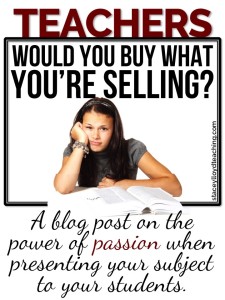Would You buy what your’re selling? The importance of passion in the classroom

[The following is a guest blog post by Lara. Read more about the author here.]
My name’s Lara. I’m a copywriter. I come up with the words that most effectively sell a product or campaign. Want to hire me?
No? Hmmm… let’s try that again.
Words have power. Words tell stories. Words are how we communicate, make connections, build relationships. The right words in the right places can inspire, compel and even convert. A picture may be worth a thousand words but only words can paint mental pictures, pictures that connect directly to your imagination – which has no limits. Carefully crafted words, skillfully strung together, speak to our emotions, our hopes and dreams, the things that make us human, that make us who we are. I am a copywriter. I don’t sell words. I sell dreams, ideas and inspiration – with my words.
How about now? Would you want to hire me?
If you found the second explanation of what I do more compelling than the first, then my words resonated with the limbic systems of your brain. These are the systems that are responsible for feelings. Like love or excitement or happiness. It also happens to be the part of the brain that controls our decision-making and behaviour. That is why so often we decide to do something – usually despite facts and logic – just because it feels right.
Nobody understands or expresses this better than Simon Sinek, an author best known for articulating the concept of the Golden Circle. As a copywriter, I am often asked to sell something: a product, an event, a service. But immediately I come up against a problem. Because, as Sinek so neatly explains, people don’t buy what you do, they buy why you do it.
I could tell you exactly how our product is better than any others on the market. I can give stats and reference results. But all I would achieve is to speak to the rational part of your brain. And how many of us have ever bought anything because it made sense? How often do we do things solely because we know it’s ‘good for us’? Hardly ever.
We choose and do things that make us feel good. That we want. That we simply feel we can’t live without.
So, as Sinek illustrates in his TED talk How great leaders inspire action, if we want to compel people to act, we need to stop selling them what we do and start selling them why we do it. And, as you might guess from his title, I am not just talking about how to sell products, I am talking about selling ideas. Politicians and revolutionaries understand the concept of selling why they do what they do at least as well as marketers do.
Sinek observes that all the greatest and most inspiring leaders – and he references Apple, Martin Luther King and the Wright brothers specifically – all had different goals. Yet they all thought, acted and communicated in the exact same way. That way happened to be the complete opposite way to everyone else.
Instead of starting with the what, they started with the why.
Martin Luther King had a dream, not a plan. He opened his famous speech by telling the people gathered why he was there, not what he wanted them to do.
Apple know that you could just as easily buy a computer somewhere else and yet people still queue for hours at the launch of their new products. Why? Because Apple understand that these people aren’t just buying their products, they’re buying into a shared ideal.
Whether your customers are consumers or voters or students, if you want them to buy into what you’re peddling you need them to believe what you believe. But you can only do this if you yourself know why you do what you do. If you start with this, they will follow you – not because they have to but because they want to.

Meet Lara - Stacey Lloyd Teaching
[…] March 18, 2015March 18, 2015 staceylloyd Guest Bloggers This is Lara. She lives in Norfolk, England in a gorgeous little Victorian terrace home with her DIY and decorating-mad fiancé – a house that is gradually getting smaller with each new coat of paint they add. She is planning her wedding for later this year, mainly by making Pinterest boards. She is a copywriter working in Cambridge who writes novels when she finds the time. She (says that) she never exercises but keeps her imagination in shape by writing for my products. Oh, and she is also my wonderful sister. You can read Lara’s first guest blog post here: Why Not What […]
Lisa
This totally makes sense! I would love to see some examples of how people do this in the classroom.